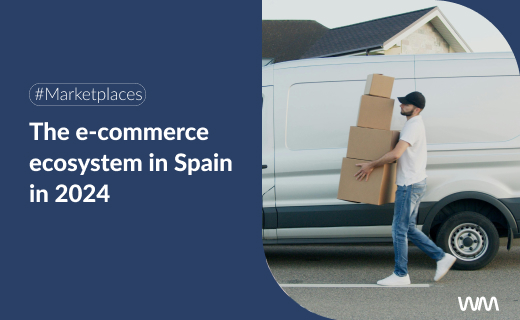E-commerce in Spain continues its unstoppable rise. We close 2024 with the latest data from the CNMC Household Panel for the second quarter of 2024, showing that 54.1% of Spaniards made an online purchase in the past six months. This figure reflects the consolidation of digital platforms as an essential part of consumer habits in the country.
Amazon: The undisputed giant of e-commerce
Within the online shopping landscape, Amazon stands out as the absolute leader. 68.4% of users chose this platform to make at least one purchase in the past six months. Moreover, over half of Spanish consumers (55.1%) made their last online purchase on Amazon, far surpassing other platforms.
Following Amazon are AliExpress, with 29.4% of users, and Zalando, with 6.3%. Meanwhile, platforms like eBay (4.3%) and Google Shopping (1%) hold more modest positions, showing that most consumers tend to concentrate on established major marketplaces.
Tourism and online services, other main players
The tourism sector also demonstrates its significant role in e-commerce. According to the report, 27.2% of Spaniards booked travel services online over the past twelve months. This includes purchasing flights, accommodations, car rentals, or organized trips. This trend highlights how digital platforms have become the first choice not only for physical products but also for experiences and services.
Other figures in the digital market
Although Amazon dominates significantly, 30.4% of consumers turned to other websites or apps for their last online purchase. This fact underscores that the Spanish e-commerce ecosystem is diverse, with room for smaller competitors offering specialized products, competitive prices, or personalized customer service.
What drives the growth of e-commerce in Spain?
Several reasons explain this continuous growth:
Convenience and speed: Consumers value the ability to shop from home with fast delivery. Wide range of options: From major marketplaces like Amazon to specialized stores, users can find almost any product. Trust in digital platforms: Improved online payment security has reinforced consumer trust. Accelerated digitalization: The pandemic solidified the adoption of digital habits, which continue to evolve.
What does the future hold for e-commerce in Spain?
In the coming years, e-commerce in Spain is expected to keep growing, driven by:
Technological innovation, such as the use of artificial intelligence to personalize user experiences. Expansion of local and regional marketplaces that offer alternatives to Amazon. For instance, TikTok Shop launched in Spain this year. Increased sustainability, with more consumers opting for eco-friendly products.
E-commerce is not just a sales channel but a key element in understanding how consumer preferences evolve. Companies that can adapt to these trends will have a competitive edge in an increasingly digital market.
Conclusion
With more than half of Spaniards shopping online, e-commerce is solidifying as a pillar of the economy. Amazon leads the race, but competitors like AliExpress, Zalando, and other marketplaces also play an important role in the ecosystem. As the market evolves, opportunities for brands and companies will continue to grow, provided they meet the demands of an increasingly demanding and digitized consumer.
Do you sell on Amazon and want to triple your sales in a year? We have the tool you need, contact us.
Follow us on LinkedIn for more news.






